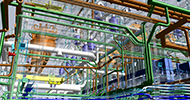Non-contact metrology generates extremely precise scans of physical objects without touching the actual workpiece. As such, it’s an extremely valuable tool for preservationists, allowing them to conveniently measure historic buildings and safely record artifacts without harming potentially irreplaceable objects.
In addition, the technology works very quickly. With its ability to create a full 3D laser scan of a historic building’s entire exterior and interior within hours, non-contact metrology saves both time and money, while capturing invaluable documentation to support conservation efforts.
Due to these benefits, preservationists around the country are adopting non-contact metrology to ensure the success of their projects. Although it’s still relatively new to the field, there are already a number of proven applications for using this technology for historic preservation, including the ability to:
- Guide a complex restoration. Non-contact metrology uses light to measure and capture every single nook and cranny of historic buildings, generating exceptionally detailed renderings. This data can guide a complex restoration project from start to finish and allow researchers to visualize different designs, so that they can accurately predict how each option will affect the look and function of the space. For example, they can determine if a new layout will feel awkward to guests before any structural changes have been made, avoiding mistakes and costly rework.
- Visualize the insides of walls and ceilings. With non-contact metrology, it’s easy to see within a historic building’s walls, ceilings and floors. This allows researchers to visualize layered changes that have been made to a structure over time, which can support their conservation efforts. For example,the technology recently revealed a 300-year-old staircase hidden within the walls of the Old State House in downtown Boston – information that could not have been uncovered otherwise.
- Provide insight into a structure’s integrity. Non-contact metrology can quickly capture the structural integrity and condition of any building. It records settling and other changes to the foundation that may have affected the site over time – all of which is critical information when attempting to restore or preserve a historic place.
- Create replicas for posterity. The high-resolution digital copies captured with non-contact metrology can also be used to create replicas of monuments and artifacts. After being sized down or printed to scale, the objects can be featured in museums and gift shops, preserving history for the next generation.














